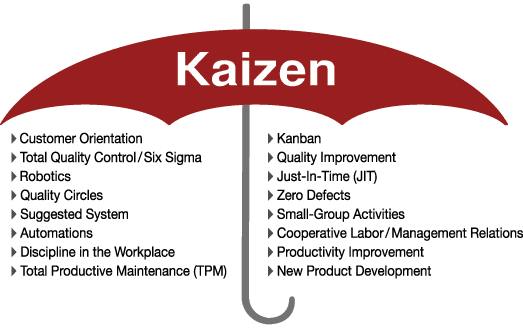Kaizen: The Road to Continuous Improvement

Kaizen, a Japanese word for “improvement”, is often used in business environments to implement and improve standardized activities & processes. Introduced by Toyota after World War II, kaizens have now become common practice in the manufacturing industry to continuously improve methods or procedures that increase productivity, eliminate waste, and/or reduce costs. However, with the vast benefits which kaizens provide to a variety of industries, they can also be applied to non-manufacturing businesses. The “kaizen mind set” is one that management and employees should embrace every day when working.
Understanding and Implementing the Kaizen Philosophy

Kaizen is now used mostly as an umbrella term that encompasses several core values and philosophies. Figure A provides a fairly complete list of its most important elements and will help to provide a greater understanding of aspects involved in continuous improvement.While these elements focus on quality control, inventory management, orientation/training, discipline, product optimization, standardization, and cooperation, the key principle behind a kaizen remains continuous cyclical improvement. Using elements listed under the umbrella, companies can systematically improve processes, reduce waste, and identify cost savings. These will ultimately strengthen current advantages while eliminating weaknesses, creating a better managed and maintained business.
The Benefit of Kaizens to Canadian Manufacturing Companies
After seeing the use of kaizens first-hand from my positions at manufacturing plants including Toyota and Rockwell Automation, I’ve recognized the benefit of continuous improvement initiatives which have translated into tangible results. From cost savings (due to better steel segregation), to quality improvements (the introduction of ISO 9001 document control), and waste reduction techniques (recycling weather strip strings), there are countless ways which continuous improvement can provide businesses with greater advantages.
Integrating Kaizens into Non-Manufacturing Businesses
Continuous improvement is a concept that can also be applied in non-manufacturing environments and everyday life. In any business there are several opportunities for continuous improvement, especially in the form of cost reductions or productivity enhancements. There are always ways to become more competitive and offer products or services which have a greater customer demand.
Read More: Improve Your Email Management for Higher Productivity: Use these steps to manage your inbox to improve productivity and reduce work-related stress.
Implementing Kaizens for your Team
Need a roadmap of how to implement the kaizen philosophy for your business? Here’s a general guideline of the steps companies should take to begin their cycle of improvement:
- As a management team, establish an environment that embraces improvement and will provide the resources to support kaizens. Strong belief in the system will be embraced by employees and unite a team around the principle of always becoming better.
- Create kaizen teams/groups that meet regularly to brainstorm ideas (This can be done daily, weekly, or monthly).
- Introduce incentive programs for employees that implement successful kaizens, such as prizes, a designated parking space, or financial rewards.
- Work with vendors and suppliers to determine if there are ways to improve logistics, increase value, reduce packaging costs, etc.
- Research the costs and structure of other vendors and suppliers.
- Research strategic partnerships and competitors to identify best business practices.
- Explore Canadian government funding programs and contact Mentor Works to help streamline the process of obtaining government grants and loans. Companies can receive funding for business expansion, capital & technology adoption, research and development, and employee hiring & training. For most incorporated companies, the easiest way to learn about programs tailored to your industry or business initiative is by registering for a complimentary small business grants webinar.
Some kaizens can be implemented in a matter of hours, while others can take years. Always remember that no kaizen is too large or too small as long as they translate into ongoing savings, productivity, or quality improvements. Kaizens keep employees engaged and help companies grow regardless of their current size or capabilities. Start implementing kaizens today and experience the benefits which continuous improvements can offer your business!
